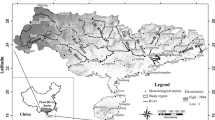Abstract
Flash floods caused by extreme rainfalls are one of the most significant natural hazards. In the present study, the precipitation data of 69 meteorological and climatological stations with temporal intervals (1961–2010) were obtained to determine the threshold of extreme precipitation as well as analyzing its significant patterns in the western regions of Iran. To determine the threshold of extreme precipitation, the theory of extreme value method was applied. In this method, precipitation of 22 mm and more than that covers 30% of the area had been identified and extracted as extreme precipitation. Therefore, 119 extreme precipitation events during the study period had been identified. Then, four patterns were analyzed using cluster analysis. After that, network data of geopotential height levels of 200, 300, 400 and 500 hPa for these days, from re-analyzed data series of NCEP/NCAR in the range of 10°–80°E and 0°–70°N and in 13,460 cells 2.5° × 2.5° were extracted by GrADS software. The results of the study showed that the most important humidity source for precipitation was the Mediterranean Sea, the Black Sea and the Red Sea, respectively. The upward vertical speed at different levels, located on the east and southeast cyclones of upper levels, which matches low pressure of the Earth’s surface, indicating unstable conditions in the region. Also, placing cutoff lows due to westerlies activities with warm and humid air advection at the surface and upper-level cold air were the main causes of severe atmospheric instability in the west of Iran.












Similar content being viewed by others
References
Alijani B, Harman JR (1985) Synoptic climatology of precipitation in Iran. Ann Assoc Am Geogr 75:404–416
Anagnostopoulou C, Tolika K (2012) Extreme precipitation in Europe: statistical threshold selection based on climatological criteria. Theoret Appl Climatol 107:479–489
Ansari S (2003) Synoptic survey of the flood-causing system in the watershed Kohgiluyeh-Boyer Ahmad. M.A. thesis, Tarbiat Moallem University, Tehran
Archer CL, Caldeira K (2008) Historical trends in the jet streams. Geophys Res Lett 35:1–6
Ashjaei B (2000) Studying and presenting models of synoptic heavy rains in the North West of Iran. M.A. thesis, Tarbiat Modares University, Tehran
Barry RG, Carleton AM (2001) Synoptic and dynamic climatology. Psychology Press, London
Barry RG, Perry AH (1973) Synoptic climatology; methods and applications. Routledge Kegan & Paul, London
Bartolini G, Morabito M, Crisci A et al (2008) Recent trends in Tuscany (Italy) summer temperature and indices of extremes. Int J Climatol 28:1751–1760
Becker S, Hartmann H, Zhang Q et al (2008) Cyclicity analysis of precipitation regimes in the Yangtze River basin, China. Int J Climatol A J R Meteorol Soc 28:579–588
Beguería S (2005) Uncertainties in partial duration series modelling of extremes related to the choice of the threshold value. J Hydrology 303:215–230
Bell GD, Keyser D (1993) Shear and curvature vorticity and potential-vorticity interchanges: interpretation and application to a cutoff cyclone event. Mon Weather Rev 121:76–102
Benestad RE (2006) Can we expect more extreme precipitation on the monthly time scale? J Clim 19:630–637
Beniston M, Stephenson DB, Christensen OB et al (2007) Future extreme events in European climate: an exploration of regional climate model projections. Clim Change 81:71–95
Change IC (2007) The physical science basis. Cambridge University Press, Cambridge, pp 748–845
Coles S, Bawa J, Trenner L et al (2001) An introduction to statistical modeling of extreme values. Springer, Berlin
Ghavidel Rahimi Y (2011) Drawing and analysis of atmospheric moisture flux convergence (MFC) during the heavy rainfall caused by Phet tropical super cyclone in Chabahar coastal region. J Spat Plan 15:101–118
Hidalgo JG, De Luis M, Raventós J et al (2003) Daily rainfall trend in the Valencia Region of Spain. Theor Appl Climatol 75:117–130
Jahanbakhsh AS, Zolfaghari H (2001) Analysis of synoptic patterns of daily precipitation in West Iran. Geogr Stud 63:234–258
Jahanbakhsh S, Jafary shandy F, Hosseinalipourgazy F (2013) The relationship between circulation patterns and super heavy rain over Azerbaijan Region. Geogr Plan 16:113–138
Keyser D, Shapiro M (1990) Fronts, jet streams and the tropopause. Extratropical cyclones: The Erik Palmén memorial volume, pp 167–191
Lashkari H (1996) Synoptic pattern of heavy precipitation of south and south West of Iran. Ph.d. thesis, Tarbiat Modares University, Tehran
Lee D-K, Park J-G, Kim J-W (2008) Heavy rainfall events lasting 18 days from July 31 to August 17, 1998, over Korea. J Meteorol Soc Jpn Ser II 86:313–333
Levine RA (2000) Statistical methods in the atmospheric sciences. J Am Stat Assoc 95:344
Mastrangelo D, Horvath K, Riccio A et al (2011) Mechanisms for convection development in a long-lasting heavy precipitation event over southeastern Italy. Atmos Res 100:586–602
Mätlik O, Post P (2008) Synoptic weather types that have caused heavy precipitation in Estonia in the period 1961–2005. Est J Eng 14:195–208
McPhaden MJ, Bahr F, Du Penhoat Y et al (1992) The response of the western equatorial Pacific Ocean to westerly wind bursts during November 1989 to January 1990. J Geophys Res Oceans 97:14289–14303
Omidvar K (2007) Analysis of synoptic and thermodynamic conditions for the occurrence of precipitation in the region puma. Geogr Stud 39:81–98
Ribatet M, Singleton R, Team RC (2011) Spatial Extremes: modelling spatial extremes. R package version, pp 1–8
Verdon-Kidd D, Kiem A (2009) On the relationship between large-scale climate modes and regional synoptic patterns that drive Victorian rainfall. Hydrol Earth Syst Sci 13:467–479
Willmott CJ (1987) Synoptic weather-map classification: correlation versus sums-of-squares. Prof Geogr 39:205–207
Author information
Authors and Affiliations
Corresponding author
Additional information
Publisher's Note
Springer Nature remains neutral with regard to jurisdictional claims in published maps and institutional affiliations.
Rights and permissions
About this article
Cite this article
Shaffie, S., Mozaffari, G. & Khosravi, Y. Determination of extreme precipitation threshold and analysis of its effective patterns (case study: west of Iran). Nat Hazards 99, 857–878 (2019). https://doi.org/10.1007/s11069-019-03779-x
Received:
Accepted:
Published:
Issue Date:
DOI: https://doi.org/10.1007/s11069-019-03779-x




